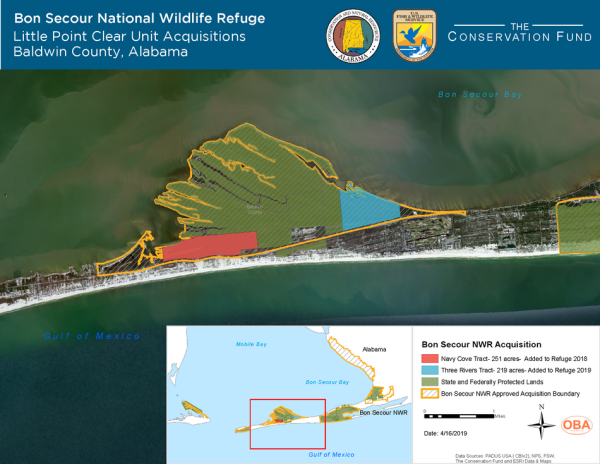
|
USFWS, the Conservation Fund, and the Alabama Department of Conservation and Natural Resources expand Alabama's coastal National Wildlife Refuge
By
Mark Davis, public affairs specialist, USFWS
Gulf Shores, AL - (OBA®) - A jewel of an ecosystem just grew by more than 350 football fields, thanks to a partnership between the U.S. Fish and Wildlife Service (Service) and several partners.
The land in question: the Bon Secour National Wildlife Refuge, a roughly 7,000-acre tract near Gulf Shores, Alabama. It’s called the Little Point Clear Unit — two parcels comprising 470 acres, enough land to accommodate 355 football games. It became a formal part of the refuge April 26.
OBA Editor Note: The Bon Secour National Wildlife Refuge is about 17 miles west of Orange Beach, Alabama.
The tract will further enhance features for which the refuge is already renowned — its fishing, wildlife viewing, photography, kayaking and more. Last year, more than 120,000 outdoor enthusiasts visited the refuge, located an hour’s drive south of Mobile.
The Conservation Fund and the Alabama Department of Conservation and Natural Resources worked with the Service to acquire the land, located on the Fort Morgan Peninsula.
“By acquiring this land, we are helping preserve land that is as valuable to wildlife as it is to anglers, hikers, boaters, bird-watchers and others who get outside,” said Leo Miranda, director of the Service’s Region 4, an area comprising 10 southeastern states as well as Puerto Rico and the U.S. Virgin Islands. “This is a win for nature as well as for the people who enjoy it.”
Among the winners: plovers — snowy, piping and Wilson plovers — plus the endangered Alabama beach mouse. They all live along the shoreline and interior terrain, as do young Kemp’s Ridley sea turtles. Conservationists also think manatees migrating through the northern Gulf of Mexico could benefit; the acquisition increases protected coastal habitat by about 25 percent.
The Conservation Fund, a nonprofit organization dedicated to land and water conservation, saving wildlife and creating community development opportunities, acquired the land.
The total purchase amount was not disclosed, but $10.2 million came from grants from the National Fish and Wildlife Federation’s (NFWF) Gulf Environmental Benefit Fund. A federal court established the fund following the 2010 Deepwater Horizonoil spill, and directs $2.54 billion to NFWF to pay for projects along areas of the gulf coast that the spill affected.
“We are delighted that NFWF recognizes the importance of increased protection for coastal resources, as well as the unique benefits it brings the community,” said Ray Herndon, director of the Central Gulf and Lower Mississippi Region for the Conservation Fund. “We look forward to continuing these efforts in partnership with the state and Service.”